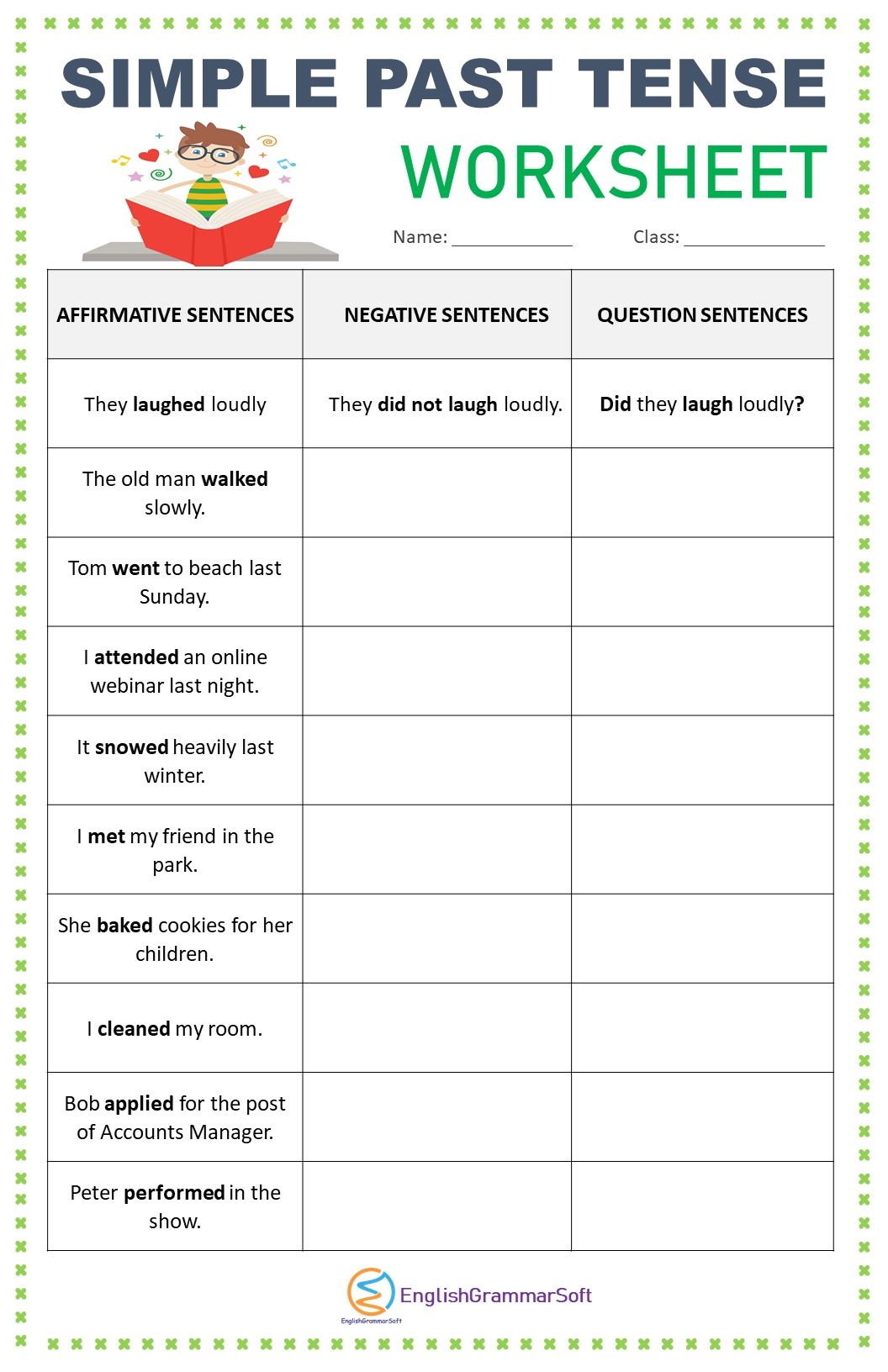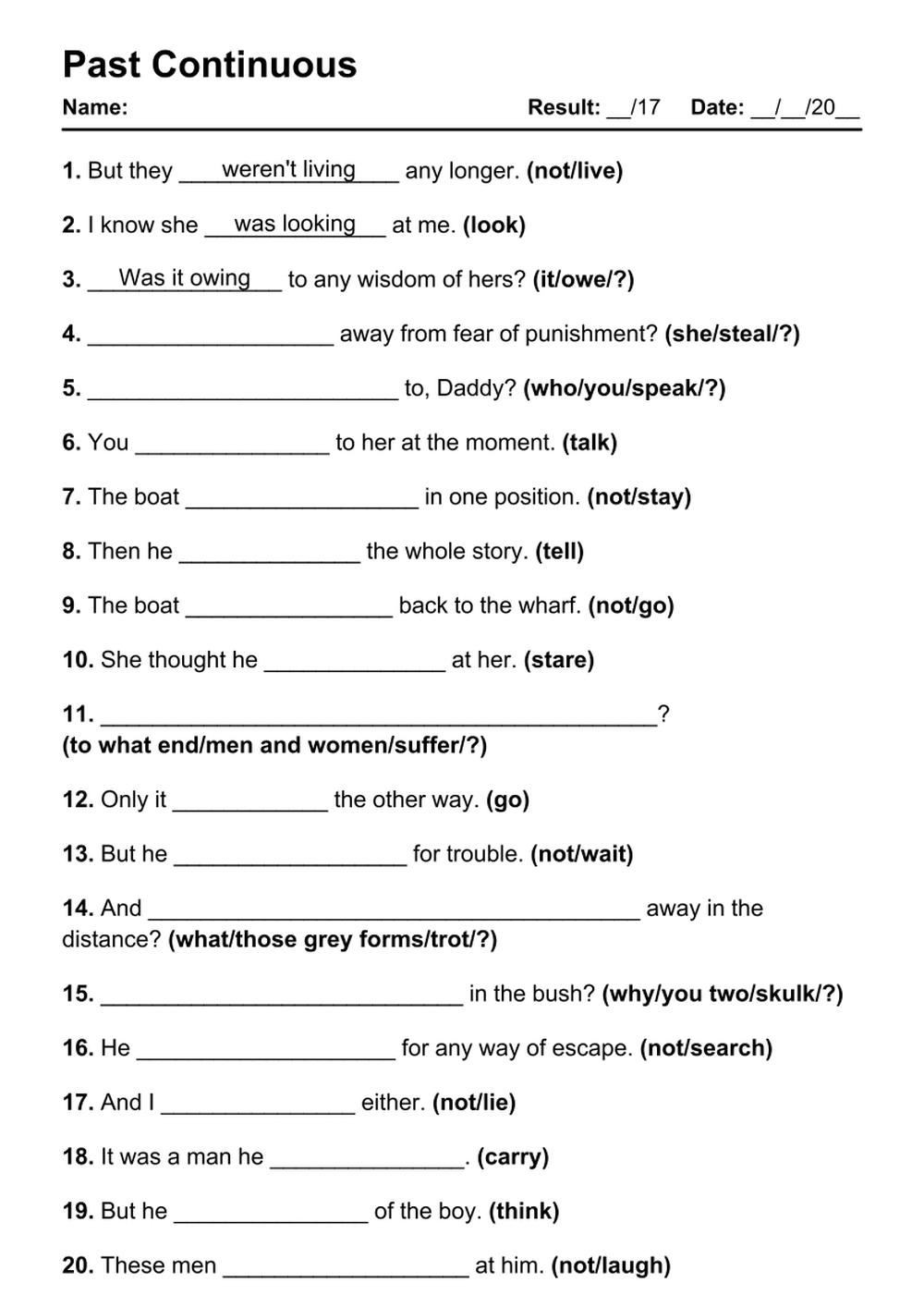
Mastering the Narrative: The Indispensable Role of Grammar Worksheets: Past Simple Tense
The English language, with its rich tapestry of tenses, allows speakers to articulate events across time. Among these, the Past Simple Tense stands as a fundamental pillar, essential for recounting stories, describing historical events, and simply talking about what happened yesterday. It is the bedrock of narrative, the chronological anchor for countless conversations. However, mastering its nuances – from regular verb conjugations to the often-tricky irregular forms, and the correct formation of negatives and questions – can be a significant challenge for language learners. This is where the power of targeted educational tools comes into play, and chief among them are well-crafted Grammar Worksheets: Past Simple Tense.
These worksheets are not merely supplementary materials; they are active learning instruments that bridge the gap between theoretical understanding and practical application. They transform passive learning into an active, engaging process, making them a cornerstone of effective language acquisition. This comprehensive guide will delve into the critical importance of the Past Simple Tense, explore why grammar worksheets are so effective, dissect the components of ideal Past Simple worksheets, and offer insights into how learners, teachers, and parents can best utilize these invaluable resources.

The Unavoidable Importance of the Past Simple Tense

Before delving into the mechanics of worksheets, it’s crucial to understand why the Past Simple Tense is so vital. It is used to describe completed actions that happened at a specific point in the past. Whether you’re recounting your weekend activities ("I went to the park."), narrating a historical event ("World War II ended in 1945."), or simply stating a fact about the past ("She lived in London for five years."), the Past Simple is indispensable.

Its complexity primarily stems from two aspects:

- Regular Verbs: These form their past simple by adding "-ed" (e.g., walk – walked, play – played, start – started). While seemingly straightforward, learners often grapple with spelling rules (e.g., doubling consonants, changing ‘y’ to ‘i’).
- Irregular Verbs: This is the true hurdle. These verbs do not follow the "-ed" rule and must be memorized individually (e.g., go – went, eat – ate, see – saw, be – was/were). There are hundreds of these, and their mastery is key to fluency.

Beyond these, learners must also correctly form negative sentences (using "did not" or "didn’t" + base verb) and questions (using "Did" + subject + base verb). Without a solid grasp of these structures, clear and accurate communication about past events becomes impossible.
Why Grammar Worksheets? The Power of Active Engagement

In an age of digital learning and multimedia resources, the humble grammar worksheet might seem old-fashioned. However, its enduring effectiveness lies in its ability to facilitate active recall and structured practice. Here’s why Grammar Worksheets: Past Simple Tense are so powerful:
- Active Learning: Unlike reading a grammar rulebook, completing a worksheet requires the learner to actively apply rules, retrieve information from memory, and construct sentences. This active engagement strengthens neural pathways and improves retention.
- Repetition and Reinforcement: Mastery comes through repetition. Worksheets provide a structured environment for learners to practice the same concepts multiple times in varied contexts, solidifying their understanding.
- Immediate Feedback: Many worksheets come with answer keys, allowing learners to check their work immediately. This instant feedback loop is crucial for self-correction and understanding where errors occur.
- Targeted Practice: Worksheets can be designed to focus on specific challenges, such as irregular verbs, negative forms, or question formation, allowing learners to hone in on their weaker areas.
- Different Learning Styles: They cater to visual learners (seeing the structures written out), kinesthetic learners (the act of writing), and logical-mathematical learners (identifying patterns and applying rules).
- Foundation for Fluency: By automating the correct usage of the Past Simple, worksheets free up cognitive load during conversation, allowing learners to focus on conveying meaning rather than struggling with verb forms.



Components of Effective Grammar Worksheets: Past Simple Tense
Not all worksheets are created equal. Effective Grammar Worksheets: Past Simple Tense are meticulously designed to guide learners through a progressive understanding of the tense. Here are the key components and types of exercises typically found:
-
Basic Identification:
- Task: Underline or circle all Past Simple verbs in a given paragraph.
- Purpose: To help learners recognize the forms in context, distinguishing them from other tenses.
-
Regular Verb Conjugation:
- Task: Fill-in-the-blanks with the correct Past Simple form of regular verbs provided in parentheses.
- Purpose: To practice adding "-ed" and reinforce spelling rules (e.g., "study" becomes "studied," "stop" becomes "stopped").
-
Irregular Verb Mastery:
- Task: Matching exercises (base form to past simple form), categorization (grouping verbs by similar past simple endings), or fill-in-the-blanks specifically targeting irregular verbs.
- Purpose: This is arguably the most critical section. It forces memorization and recall of the often unpredictable irregular forms. Worksheets can introduce these in manageable chunks.
-
Negative Form Practice:
- Task: Rewrite affirmative sentences into negative ones, or complete sentences using the negative Past Simple.
- Purpose: To practice the structure "did not/didn’t + base verb," ensuring learners don’t incorrectly add "-ed" to the main verb after "did."
-
Question Form Practice:
- Task: Rewrite statements as questions, or answer questions using the Past Simple.
- Purpose: To master the "Did + subject + base verb" structure for yes/no questions and the placement of question words (Who, What, Where, When, Why, How) for information questions.
-
Mixed Practice:
- Task: Exercises combining affirmative, negative, and interrogative forms of both regular and irregular verbs in various contexts.
- Purpose: To simulate real-world usage where all forms are intertwined, challenging learners to switch between structures.
-
Contextual Practice (Short Stories/Dialogues):
- Task: Complete gaps in a short narrative or dialogue using the correct Past Simple forms.
- Purpose: To show the tense in meaningful context, helping learners understand its communicative function rather than just its grammatical rules.
-
Error Correction:
- Task: Identify and correct grammatical errors related to the Past Simple Tense in given sentences.
- Purpose: To develop critical thinking and an eye for common mistakes.
-
Creative Writing/Personalization:
- Task: Prompts like "Write about your last holiday using the Past Simple" or "Describe a memorable event from your childhood."
- Purpose: To encourage free production, allowing learners to apply what they’ve learned in a personal and meaningful way, fostering fluency and confidence.
Designing and Implementing Grammar Worksheets: Past Simple Tense
The versatility of Grammar Worksheets: Past Simple Tense makes them adaptable for various learning environments:
For Teachers:
- Warm-ups: Quick exercises to review previous lessons.
- In-class Practice: Structured activities for guided or independent practice.
- Homework: Reinforcement outside the classroom.
- Assessment: Diagnostic tools to identify areas of difficulty or evaluate progress.
- Differentiation: Worksheets can be tiered to cater to different proficiency levels within the same classroom.
- Scaffolding: Start with highly controlled exercises and gradually move to more open-ended tasks.
For Learners (Self-Study):
- Consistency is Key: Dedicate regular, short periods to practice rather than sporadic long sessions.
- Use Answer Keys Wisely: Try to complete the worksheet first without peeking, then check your answers. Understand why an answer is correct or incorrect.
- Identify Patterns: Pay special attention to irregular verbs you repeatedly get wrong and create personal lists or flashcards for them.
- Integrate with Other Skills: After completing a worksheet, try to use some of the practiced sentences in a speaking exercise or write a short paragraph.
For Parents:
- Support, Don’t Just Correct: Encourage effort and progress, not just perfection.
- Make it Fun: Turn it into a game, or connect the sentences to real-life experiences.
- Patience: Learning a new language takes time and consistent effort.
Benefits Beyond Grammar
The advantages of engaging with Past Simple worksheets extend beyond mere grammatical accuracy:
- Vocabulary Expansion: Many exercises naturally introduce new verbs and context-specific vocabulary.
- Reading Comprehension: Understanding the actions and timelines in sentences and paragraphs enhances reading skills.
- Writing Fluency: Consistent practice improves the ability to construct coherent and grammatically correct sentences, leading to more fluid writing.
- Confidence Building: Each correctly completed exercise builds a learner’s confidence in their ability to use English effectively.
- Critical Thinking: Error correction tasks, in particular, hone analytical skills.
Digital vs. Printable Worksheets
In the digital age, both printable and interactive online Grammar Worksheets: Past Simple Tense have their merits:
- Printable Worksheets: Offer a tangible experience, allowing learners to write, highlight, and annotate. They reduce screen time and are accessible without an internet connection.
- Digital Worksheets: Can offer instant feedback, interactive elements (like drag-and-drop), multimedia integration (audio/video prompts), and automated scoring. They are often more engaging for tech-savvy learners and can track progress over time.
A hybrid approach, utilizing the strengths of both, often proves most effective.
Tips for Maximizing Worksheet Effectiveness
- Start Simple, Build Up: Don’t overwhelm yourself or your students. Begin with basic identification and regular verbs before moving to irregulars and complex sentence structures.
- Focus on Understanding, Not Just Memorization: Encourage learners to articulate why a certain form is used.
- Integrate with Speaking and Listening: After completing a worksheet, practice saying the sentences aloud or engaging in a short conversation using the Past Simple.
- Review Regularly: Periodically revisit older worksheets or create review exercises to ensure long-term retention.
- Make it Engaging: Use relatable scenarios, interesting stories, or even incorporate humor to keep learners motivated.
Conclusion
The Past Simple Tense is more than just a grammatical rule; it’s a storytelling device, a historical record keeper, and an everyday communication tool. Its mastery is non-negotiable for anyone aspiring to fluency in English. In conclusion, Grammar Worksheets: Past Simple Tense are indispensable allies in this journey. They provide the structured, repetitive, and active practice necessary to transform abstract rules into ingrained habits. By engaging with these well-designed tools, learners can systematically conquer the complexities of regular and irregular verbs, confidently form negatives and questions, and ultimately unlock their ability to recount the past with clarity and precision, paving the way for richer, more meaningful communication.
